Cobbs Creek Reservoir
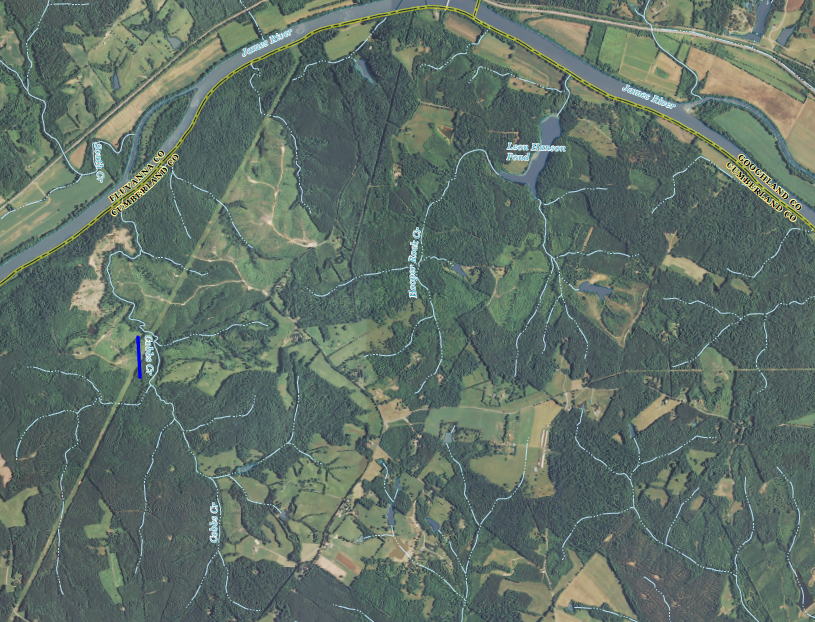
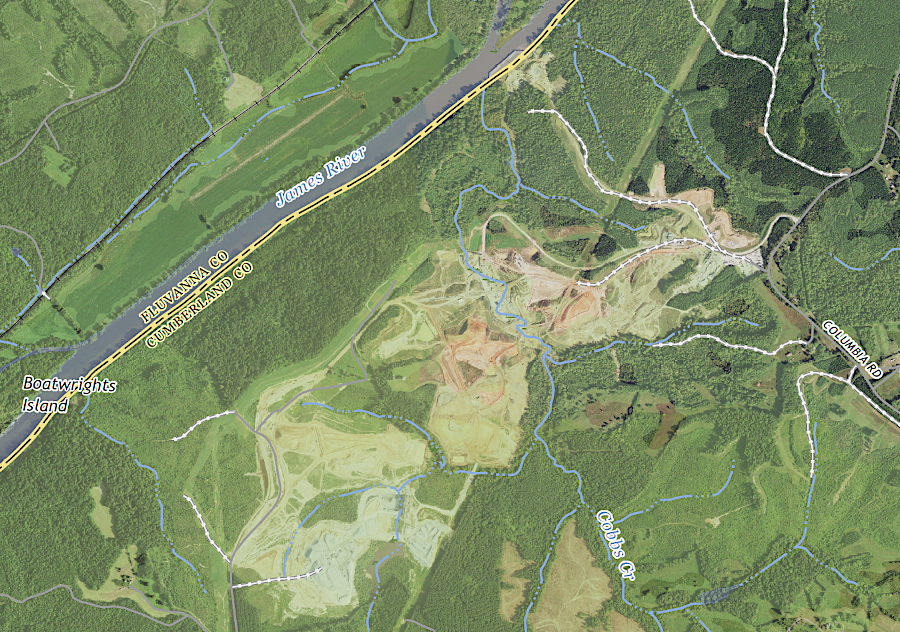
Cobbs Creek in Cumberland County was dammed to form a new drinking water reservoir for Henrico, Powhatan, Goochland and Cumberland counties
Source: US Geological Survey (USGS), Lakeside Village 1:24,000 scale topographic map (2013, Revision 1); Lakeside Village 1:24,000 scale topographic map (2022)
After the 2002 drought, the state required all localities to develop long-range water supply plans. Cumberland County started planning a new reservoir on Cobbs Creek in Cumberland County, then arranged with Henrico County to purchase the land and build the new water storage system. Powhatan County and Goochland County were also recruited to share costs and water, so Cobbs Creek Reservoir became a regional water supply project.
Three dams were built to block flow of the creek. Runoff from the Cobbs Creek watershed behind the high dams would not be sufficient to provide a reliable water source; the watershed is too small. Instead, when the James River is at high flow during the winter, excess river water (up to 150 million gallons/day) is pumped uphill into the Cobbs Creek Reservoir.
Dam construction was projected to be completed in 2019, with an additional two years to fill the 1,100-acre reservoir. In the end, the dams were completed and the 14.8-billion-gallon regional water supply impoundment began filling in May, 2024.1
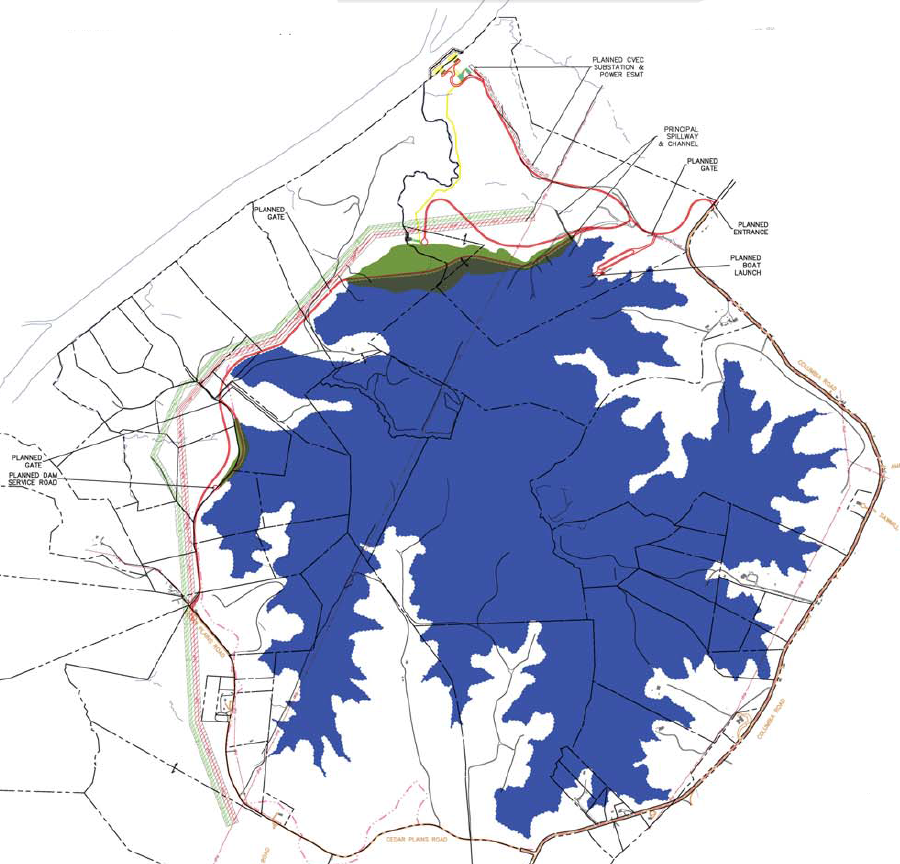
the planned Cobbs Creek Reservoir requires two dams (shown in green), including one 35' high to block potential overflow on the western edge
Source: Henrico County, Cobbs Creek Reservoir Map
A larger dam on the James River itself, creating a new lake on the main stem, would provide more water storage - but a new dam blocking the primary channel of a major river is no longer a viable option. Such a dam would flood wetlands, farmland, and historical resources, as well as interfere with fish migration. Tapping the James River only at high flow times will ensure that withdrawals will not reduce water flow below the minimums required for fish during periods of drought.
No water treatment plant is planned for the Cobbs Creek Reservoir, and the water stored in the reservoir will not be delivered to Henrico County's existing water treatment plant via pipeline. Instead, water will be released from the reservoir during periods of high demand. The released water will augment the natural flow in the James River and provide wildlife benefits; the natural river channel was used rather than a long concrete pipeline.
Henrico planned to withdraw up to 30 million gallons/day at its raw water intake near Boshers Dam. Cumberland County will withdraw up to 7 million gallons/day, and Powhatan will withdraw up to 10 million gallons/day, at sites to be determined later by those two counties.
The Department of Environmental Quality authorized withdrawal of 47 million gallons/day from the James River to fill the reservoir. Henrico County already had permission to withdraw 75 million gallons per day for its drinking water treatment plant on Three Chopt Road near Gaskins Road through 2060. The water to be released from the Cobbs Creek Reservoir was included within that total.
In addition, the county had contracted with the City of Richmond to purchase 35 million gallons per day through 2040. Henrico County was planning ahead for substantial growth when it obtained the state's permission to fill the Cobbs Creek Reservoir. The county ensured the rights to withdraw 110 million gallons/day from the James River through 2060, at a time when the county was using just 42 million gallons/day.
Henrico County purchased 1,830 acres in Cumberland County. To replace the property taxes, Henrico County committed to pay $1.13 million annually to Cumberland County.
Building an off-stream storage reservoir ensure that Henrico County could supplement flow in the James River in times of drought, mitigating the impact of its withdrawal. The Henrico County Public Utilities Director said:2
- DEQ would not have simply granted a new permit to withdraw more water to accommodate future growth... Henrico had to do something to offset the future water withdrawals, and building a reservoir was our best option.
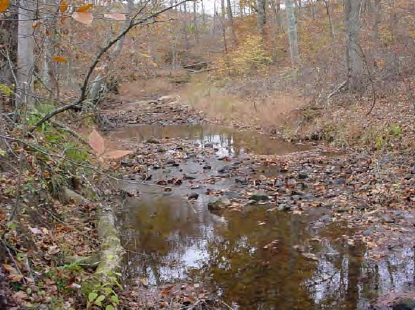
Cobbs Creek, at the location for the reservoir, was a small stream in Cumberland County
Source: Virginia Section: American Water Works Association 2011 conference, Reservoir Development for Sustainable River Management - Cobbs Creek Reservoir
Combining the requirements from multiple counties resulted in one large 1,110-acre reservoir ("one of the largest, if not the largest, municipally owned reservoir in Virginia") that will flood 31 acres of wetlands and 15 miles of streams. If separate jurisdictions had chosen to build multiple small reservoirs on different tributary streams, riparian zones on multiple streams would have been impacted.
The wetlands and riparian zone of Cobbs Creek will be drowned by the new reservoir, but consolidating requirements will result in a higher dam that will flood more acres of upland forests - rather than multiple strips of wetlands and riparian areas on multiple tributaries.3
The counties were required to mitigate the environmental impacts of the project, and the mitigation strategy was controversial because 75% of it was based on adding additional legal protection to streams in Cumberland State Forest. That state-owned forest was already being managed to meet environmental objectives.
The counties claimed they were offsetting the impacts of flooding the Cobbs Creek watershed by putting $9.8 million into a Virginia Department of Forestry stream mitigation fund, highlighting that the state forest was not required by the Chesapeake Bay Preservation Act to maintain 100-foot riparian buffers. Cumberland State Forest is located in Cumberland County, outside the Tidewater counties subject to the act, but for over 50 years the state has maintained protected buffers in the forest twice the width required for reservoir mitigation.
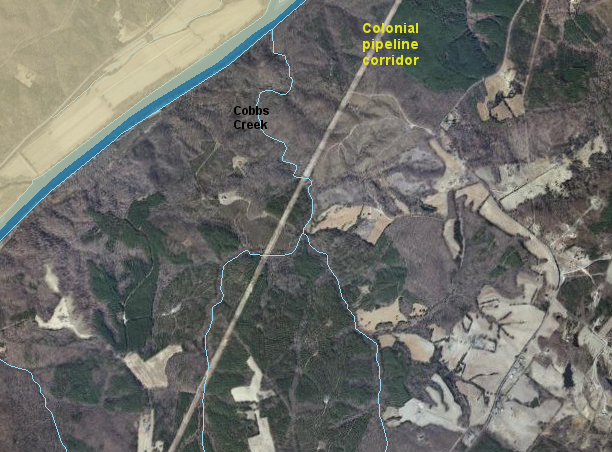
the Cobbs Creek Reservoir will require relocating oil pipelines and electrical transmission lines
Source: Cumberland County Online GIS System
Owners of private wetland mitigation banks had hoped that mitigation would require the counties to purchase "credits," which were available from the creation of new wetlands and preservation of other streams. Henrico County did purchase credits for the project's 31 acres of wetland impacts and 25% of the required stream preservation credits, but prohibited bidders from publicly opposing the mitigation plan. A member of the House of Delegates from Cumberland County stated his opposition clearly:4
- While I support the reservoir project and agree that it is an important water supply development for Henrico County, I remain concerned that its reliance on an unprecedented and highly questionable mitigation scheme, using mitigation credits of dubious value derived from state forest property, is unwise.
No site for a water reservoir is "perfect." Flooding the Cobbs Creek watershed required relocating existing high-voltage electrical transmission powerlines. Relocation was also required for 32 and 36 inch pipelines. Those two Colonial pipelines transported over 100 million gallons/day of refined petroleum products from refineries on the Gulf Coast to customers in Maryland and near New York City. Relocation costs for utility infrastructure exceeded $50 million, a substantial percentage of the projected $280 million cost.5
Links
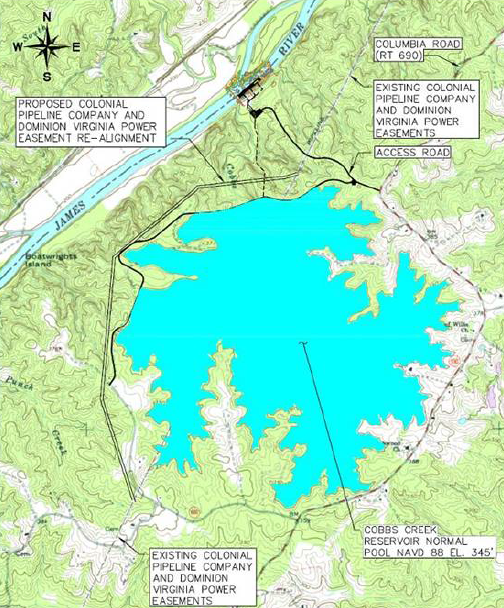
planned Cobbs Creek Reservoir, in Cumberland County
Source: Reservoir Development for Sustainable River Management - Cobbs Creek Reservoir
References
1. "New reservoir a decade away for Henrico, but work is fast-paced," Richmond Times-Dispatch, July 15, 2012, http://www.timesdispatch.com/news/new-reservoir-a-decade-away-for-henrico-but-work-is/article_a3f1c1c8-0918-5b89-bd9d-251d5cff1d8b.html; "Virginia Water Supply Snapshot: Progress Report on Cobbs Creek Reservoir Project in Cumberland County," Virginia Water Central News Grouper, July 25, 2012, https://vawatercentralnewsgrouper.wordpress.com/2012/07/25/virginia-water-supply-snapshot-progess-report-on-cobbs-creek-reservoir-project-in-cumberland-county/; "Cobbs Creek Reservoir," Henrico County, https://henrico.gov/projects/cobbs-creek-reservoir/ (last checked October 13, 2025)
2. "Cobbs Creek Reservoir Project," Cumberland County, http://www.coastals.org/forum/download.php?id=1487&sid=27bad5f6bebbbd67d63f3a656dc090c4; "Construction to begin on Cobbs Creek Reservoir," Henrico Today, Volume 18, Number 2 (Spring 2015), https://henrico.gov/assets/HT_Spring_2015.pdf (last checked October 13, 2025)
3. "State water board approves disputed offset plan for Cobbs Creek Reservoir," Richmond Times-Dispatch, June 18, 2013, http://www.timesdispatch.com/news/local/henrico/state-water-board-approves-disputed-offset-plan-for-cobbs-creek/article_b28cca1f-554b-53c1-ad78-0fa4be853c4f.html; "Henrico County PUD Cobbs Creek Reservoir," Energy and Infrastructure, http://www.energyandinfrastructure.com/index.php/sections/profiles1?start=8 (last checked February 9, 2015)
4. "Report on Stream and Wetland Mitigation Proposals and Plans for the Henrico County Cobbs Creek Reservoir," National Mitigation Banking Association, August 28, 2012, www.mitigationbanking.org/pdfs/cobbscreekreport.pdf; "State water board approves disputed offset plan for Cobbs Creek Reservoir," Richmond Times-Dispatch, June 18, 2013, http://www.richmond.com/news/local/henrico/article_b28cca1f-554b-53c1-ad78-0fa4be853c4f.html (last checked October 31, 2013)
5. "Pipeline to closely skirt giant Henrico reservoir," Richmond Times-Dispatch, February 8, 2015, http://www.richmond.com/news/local/henrico/article_273e1f1f-35f8-5ed1-8594-54f39fef515d.html (last checked February 9, 2015)
Rivers and Watersheds in Virginia
Virginia Places





